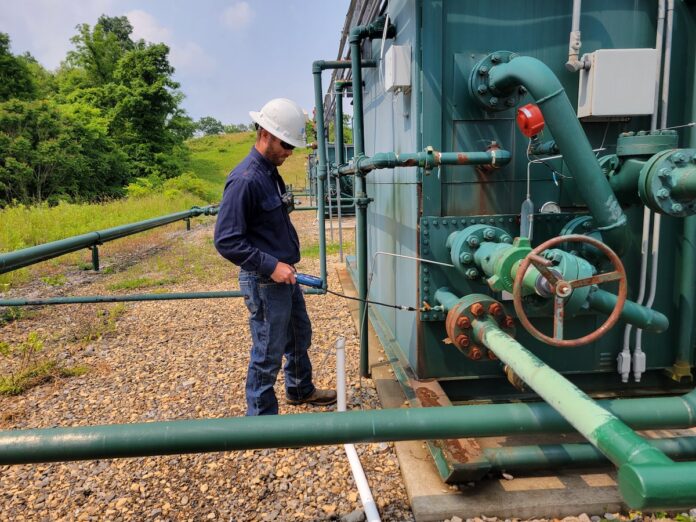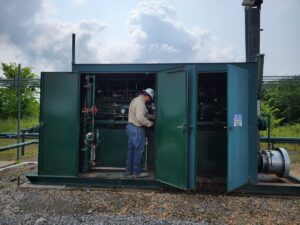
WASHINGTON, Pa. — No one likes methane leaks. They’re bad for the environment, with methane emissions contributing significantly to anthropogenic climate change and polluting the nearby air and water. Leaks are also costly for the oil and gas industry, which loses marketable product every time methane leaks into the atmosphere.
So, in order to be sustainable, both financially and environmentally, many companies are pledging to reduce leaks and other emissions.
One of those companies is Diversified Energy, the largest owner of oil and gas wells in the country and a major player in the region’s oil and gas industry. The company made its bones buying decades-old marginal wells and keeping them productive. It’s faced criticism for this business model that some say allows dysfunctional wells to continue leaking methane.
Despite this, Diversified announced in its latest corporate sustainability report that it inspected 100% of its Appalachian wells for leaks last year.
That was no small feat considering the company owns more than 50,000 wells in the region. That includes more than 22,000 wells in Pennsylvania, 23,000 in West Virginia and 7,000 in Ohio, as well as wells in Kentucky, Tennessee and Virginia.
The boots-on-the-ground surveys found most of Diversified’s infrastructure was tight, meaning no leaks were detected, said Paul Espenan, senior vice president of environmental and safety for Diversified.
“In 2022, we found we were 90% tight,” Espenan said. “In successive surveys, we got to 95% tight.”
Why
Diversified, headquartered in Alabama, is now expanding its efforts to inspect all of its 7,500 wells in Texas, Louisiana and Oklahoma for leaks.
“We’re doing it because it’s the right thing to do,” Espenan said.
But that’s not the only reason. Diversified Energy — publicly traded on the London Stock Exchange which requires Environmental, Social and Governance, or ESG, reporting from its companies — has a goal to reach net zero carbon emissions by 2040. It might sound impossible for a company dealing in fossil fuels to become net zero, but Espenan says Diversified is already well on its way.

The company reported it reduced its direct methane emissions by 25% since 2020, to 1.2 MT CO2e per MMcfe. Its new program to find and fix leaks was the largest contributor to that reduction, according to the sustainability report.
Oil and gas production is one of the largest contributors of methane emissions in the country, according to the U.S. Environmental Protection Agency. Methane, which is 25 times more potent than carbon dioxide, accounts for about 11% of emissions in the U.S., compared with carbon dioxide’s 79%.
Methane has a much higher-heat trapping potential than carbon dioxide, but it breaks down in the atmosphere much faster. That means cutting methane emissions could have a significant impact on cutting overall greenhouse gas emissions, and potentially reducing the immediate impacts of human-caused climate change.
There’s also the money. Methane is the primary component of natural gas, so when it leaks out of a loose valve or a faulty fitting, the company is losing its valuable product. Reports have found that fixing methane leaks could save energy companies billions of dollars.
“We sell natural gas, so we want to put it back in the pipe,” Espenan said.
Criticism
While these efforts are significant, Diversified has been criticized often by environmental groups for the types of wells it operates and the way it operates them. These groups argue the company is kicking the can down the road when it comes to plugging wells and, in the process, allowing marginal wells to continue leaking methane. The company has also been accused of underreporting emissions to regulators.
Reporters with Bloomberg in 2021 took a handheld gas detector and FLIR camera to inspect a few dozen Diversified wells on public lands and found leaks at most of them, including some the company reported to the Pennsylvania Department of Environmental Protection were not leaking.
The company responded to the story, which came out before Diversified launched its emissions reduction program, by fixing the reported leaks and reiterating its commitment to take care of its assets.
“The company complies with all state and federal regulatory requirements and has undertaken key environmental initiatives over the past few years to directly measure, report and reduce emissions,” the company said in a statement, to Farm and Dairy.
How
Most of Diversified’s methane emissions come from leaks, also called “fugitive emissions,” and from gas-driven pneumatic devices, according to its sustainability report.

Diversified also spent $1.4 million to train and equip its 600 Appalachian field workers, called lease operators, to become leak detection and repair, or LDAR, techs. These employees are already visiting these sites regularly in the daily course of their jobs, so it made sense to train them instead of contracting out this work.
Espenan said they did 167,000 LDAR surveys on the ground in 2022. Wells are inspected quarterly. Operators go over everything with handheld gas detectors. The detector is highly sensitive. When it detects a leak over 500 ppm, the device lets out a shrill alarm.
Each leak is written up, even if it could be easily fixed with the turn of a wrench, said Jason Mounts, director of operations for Diversified Energy. Others might involve changing out a part.
Operators demonstrated how they comb over each fitting, flange and valve with the GT-44 during a site tour June 16, at a well pad in Washington County.
Surveying an unconventional well pad with multiple well heads could take between 30-45 minutes. Going over one conventional well head and its associated equipment could take about five minutes.
The company spent nearly $1 million last year to convert 57 facilities from gas-based pneumatic devices, which are designed to vent a small amount of natural gas through regular operations, to compressed air. Espenan said they plan to do another 50 in the coming year.
Diversified also launched a program to survey all of its pipelines and other midstream facilities for leaks. It contracted out this work to Bridger Photonics, a Montana-based company that uses aerial Light Detection and Ranging, or LiDAR. So far, 11,000 miles of pipeline, or about 60% of the company’s assets have been surveyed.
“Can an oil and gas company be net zero? Yes, absolutely,” Espenan said. “We have charted a real path to obtain that.”
(Reporter Rachel Wagoner can be reached at 724-201-1544 or rachel@farmanddairy.com.)










There is no net zero folks.